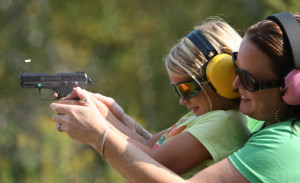It’s time to revisit early education about firearms, given several recent news stories. Human beings’ long childhoods enable the acquisition of vast amounts of knowledge and skills. What is learned depends on parents’ priorities and experiences.
A new wrinkle has appeared with the current generation, which seems to prefer to feel safe rather than acting to be safe. This is the difference between controlling others’ guns versus controlling one’s own gun as divergent routes to gun safety.
This ball began rolling in 1993 when Arthur Kellermann and others published an article in the New England Journal of Medicine titled “Gun Ownership as a Risk Factor for Homicide in the Home”. Their conclusion was that any “guns … actually pose a substantial threat to members of the household. People who keep guns in their homes appear to be at [about 2.7 times] greater risk of homicide in the home than people who do not.”
The article promoted the idea that the mere presence of guns, especially in homes and above all for children, is itself dangerous. But the study’s skewed data collection and analysis invalidate its findings for general purposes. Since then, scholars have pointed out similar problems with other work proclaiming fearsome consequences from being in the general vicinity of a firearm.
Pseudoscience like this encourages contemporary life control activists to imagine they can change America’s long, strong relationship with firearms to one of disdain, to “make firearms uncool”. The underlying reason for such desires is unaddressed irrational fear, leading to attempts to keep guns out of everyone’s lives and pushing for everyone to live lives without guns (which can lead to unfortunate consequences).
Such myths live on as articles of faith for fervent anti-gun believers. But they fool only some of the people some of the time. The truth is that responsible, knowledgeable gun users are involved in almost no homicides and in very rare accidents (which are nearly always due to carelessness).
The pretense that one can avoid firearms is not rational or safety-conscious. That’s impossible over the average American lifespan, because of the tradition and popularity of civilian gun ownership across this country. Educating children about what they may encounter during their lives is important for their well-being.
A popular single session program called Gun Stop in Sidman, Pennsylvania teaches kindergartners (with a refresher in third grade) what to do when they come across a gun, along with good ways to manage anger. This is based on NRA’s Eddie Eagle GunSafe curriculum with appearances by McGruff the Crime Dog.
Even Gabby Giffords’ husband Mark Kelly praises the Eddie Eagle program. “Stop! Don’t touch. Run away. Tell a grown-up.” Who could object? Jennifer Hoppe of Moms Demand Action does, claiming this imposes adult responsibility on children and falsely depicts the NRA as a positive force for gun safety.
These sessions alone don’t necessarily change children’s behavior. But it is as important a safety message as “Stop, drop and roll” about fire and deserves repetition. It has to be reinforced at home in order to stick, which will likely happen in Sidman where 4 out of 5 homeowners own guns.
The children of Moms who Demand Action probably won’t get that life-saving lesson. We know that some children in Houston, Texas don’t, whose mothers “have told our children that, if you see someone with a gun, run, scream … they’re scared. They’re very scared.”
No kidding, with that kind of role modeling. Children handle situations best when their parents have helped them feel confident about what to do, not when they’ve been terrified or have no idea what should happen.
An extreme demonstration of that attitude is ‘swatting’ anyone seen carrying a gun, regardless of laws expressly permitting it. The Coalition to Stop Gun Violence urged this on its Facebook page: “If you see someone carrying a firearm … and have ANY doubts about their intent, call 911 immediately … [because of] weak gun laws that arm individuals in public with little or no criminal and/or mental health screening.”
Though I support the right, I’m no advocate of open carrying because of the risks. ‘Swatting’ has so far led to at least two deaths, of an unsuspecting father of two carrying a new BB gun whom police shot dead in a Walmart and another shopper who died of a heart attack running away from the incident. The complainant didn’t know what he was seeing; no one else observed any threatening behavior. (We await news of the civil suits to come.)
Government mandates make little difference, unless a law becomes a teaching tool. A new Boston ordinance authorizes police to confiscate fake or toy guns that look too much like the real things. Awkwardly, the mayor also acknowledged “we can’t charge people for carrying toy guns around the city of Boston. They’re legal.”
The value of this will lie only in whether parents prevent their children from playing with these replicas. That’s good parenting wherever kids can get mistaken for criminals. But it does nothing to prepare them for what to do when they see a real gun, which will be no less common in Boston or anywhere else. And real bad guys will still remove the orange tips of toy guns in order to intimidate victims.
Misinforming children about the world and how to live in it stunts their development. It’s especially sad because in childhood life lessons can be so readily absorbed. Inculcating fear and denial in children, like so many anti-gun tactics, increases risks of harm throughout life.

— DRGO editor Robert B. Young, MD is a psychiatrist practicing in Pittsford, NY, an associate clinical professor at the University of Rochester School of Medicine, and a Distinguished Life Fellow of the American Psychiatric Association.

